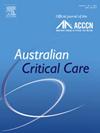回顾性回顾5年来儿科重症监护病房中被认为不适合器官捐献的患者特征
IF 2.6
3区 医学
Q2 CRITICAL CARE MEDICINE
引用次数: 0
摘要
器官移植名单上的儿童比成人患者更容易出现并发症或在等待移植期间死亡。这反映了儿童经常需要大小匹配的器官,而这些器官很少能得到。本研究的目的是回顾儿科重症监护病房5年来被认为不适合器官捐赠的患者的特征,以确定实践改进的机会。方法采用描述性设计,采用定量、回顾性、观察性研究。从临床重症监护数据库STATIC中提取2018年1月1日至2022年12月31日死亡儿童的数据到Microsoft Excel中。对数据进行描述性分析。结果5年间,226名儿童死亡;94例(41%)转到国家器官捐赠服务机构DonateLife, 26例(11.5%)成为器官捐赠者。大多数儿童死于心脏病。在死亡的儿童中,152人(66%)被认为不适合器官捐赠。儿童被认为不适合器官捐献的最常见原因如下:器官功能差(46%)、已有全身性疾病(34%)、败血症(15%)、年龄太小(10.5%)和立法原因(9.8%)。结论:本研究确定了不适合器官捐献的患者队列。根据已发表的证据,其中一些患者可能适合或可以考虑进行器官捐赠。确定这些队列可以优化关于供体适宜性的知识转化,从而增加器官捐赠的机会。本文章由计算机程序翻译,如有差异,请以英文原文为准。
A retrospective review of the characteristics of patients deemed unsuitable for organ donation in a paediatric intensive care unit over a 5-year period
Introduction
Children on organ transplant lists are more likely than adult patients to develop complications or die whilst waiting for a transplant. This reflects children's frequent need for size-matched organs, which are rarely available.
Objectives
The aim of this study was to review characteristics of patients deemed unsuitable for organ donation in a paediatric intensive care unit over a 5-year period to identify opportunities for practice improvement.
Methods
This was a quantitative, retrospective, observational study, using a descriptive design. Data were extracted from the clinical intensive care database STATIC into Microsoft Excel for children who died between the 1st of January 2018 and the 31st of December 2022. Data were analysed descriptively.
Results
Across the 5 years, 226 children died; 94 (41%) were referred to the state organ donation service DonateLife, and 26 (11.5%) became organ donors. Most children died from a cardiac cause. Of the total children who died, 152 (66%) were deemed to be unsuitable for organ donation. The most common reasons for children being deemed unsuitable for organ donation were as follows: poor organ function (46%), pre-existing systemic disease (34%), sepsis (15%), too young (10.5%), and due to legislation (9.8%).
Conclusion
This study identified cohorts of patients who were deemed unsuitable for organ donation. Based on published evidence, some of these patients may have been suitable or could have been considered for organ donation. Identifying these cohorts may optimise knowledge translation regarding donor suitability, with the outcome of increasing organ donation opportunities.
求助全文
通过发布文献求助,成功后即可免费获取论文全文。
去求助
来源期刊

Australian Critical Care
NURSING-NURSING
CiteScore
4.90
自引率
9.10%
发文量
148
审稿时长
>12 weeks
期刊介绍:
Australian Critical Care is the official journal of the Australian College of Critical Care Nurses (ACCCN). It is a bi-monthly peer-reviewed journal, providing clinically relevant research, reviews and articles of interest to the critical care community. Australian Critical Care publishes peer-reviewed scholarly papers that report research findings, research-based reviews, discussion papers and commentaries which are of interest to an international readership of critical care practitioners, educators, administrators and researchers. Interprofessional articles are welcomed.
 求助内容:
求助内容: 应助结果提醒方式:
应助结果提醒方式:


